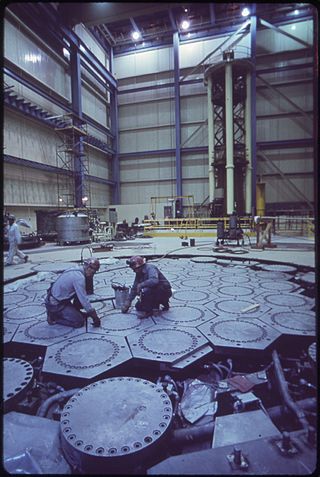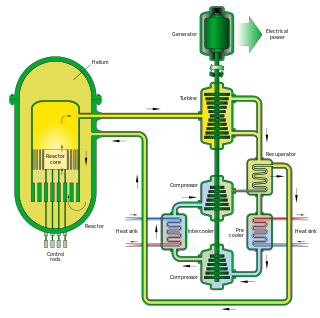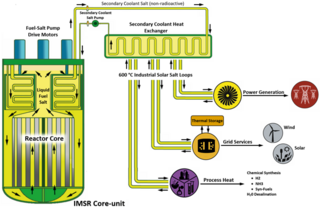Related Research Articles

The Pebble Bed Modular Reactor (PBMR) is a particular design of pebble bed reactor developed by South African company PBMR (Pty) Ltd from 1994 until 2009. PBMR facilities include gas turbine and heat transfer labs at the Potchefstroom Campus of North-West University, and at Pelindaba, a high pressure and temperature helium test rig, as well as a prototype fuel fabrication plant. A planned test reactor at Koeberg Nuclear Power Station was not built.

A molten salt reactor (MSR) is a class of nuclear fission reactor in which the primary nuclear reactor coolant and/or the fuel is a mixture of molten salt with a fissionable material.

The supercritical water reactor (SCWR) is a concept Generation IV reactor, designed as a light water reactor (LWR) that operates at supercritical pressure. The term critical in this context refers to the critical point of water, and must not be confused with the concept of criticality of the nuclear reactor.
Generation IVreactors are nuclear reactor design technologies that are envisioned as successors of generation III reactors. The Generation IV International Forum (GIF) – an international organization that coordinates the development of generation IV reactors – specifically selected six reactor technologies as candidates for generation IV reactors. The designs target improved safety, sustainability, efficiency, and cost. The first commercial Gen IV plants are not expected before 2040–2050, although the World Nuclear Association in 2015 suggested that some might enter commercial operation before 2030.

A high-temperature gas-cooled reactor (HTGR) is a type of gas-cooled nuclear reactor which use uranium fuel and graphite moderation to produce very high reactor core output temperatures. All existing HTGR reactors use helium coolant. The reactor core can be either a "prismatic block" or a "pebble-bed" core. China Huaneng Group currently operates HTR-PM, a 250 MW HTGR power plant in Shandong province, China.

The gas-cooled fast reactor (GFR) system is a nuclear reactor design which is currently in development. Classed as a Generation IV reactor, it features a fast-neutron spectrum and closed fuel cycle for efficient conversion of fertile uranium and management of actinides. The reference reactor design is a helium-cooled system operating with an outlet temperature of 850 °C (1,560 °F) using a direct Brayton closed-cycle gas turbine for high thermal efficiency. Several fuel forms are being considered for their potential to operate at very high temperatures and to ensure an excellent retention of fission products: composite ceramic fuel, advanced fuel particles, or ceramic clad elements of actinide compounds. Core configurations are being considered based on pin- or plate-based fuel assemblies or prismatic blocks, which allows for better coolant circulation than traditional fuel assemblies.

The lead-cooled fast reactor is a nuclear reactor design that features a fast neutron spectrum and molten lead or lead-bismuth eutectic coolant. Molten lead or lead-bismuth eutectic can be used as the primary coolant because especially lead, and to a lesser degree bismuth have low neutron absorption and relatively low melting points. Neutrons are slowed less by interaction with these heavy nuclei and therefore, help make this type of reactor a fast-neutron reactor. In simple terms, if a neutron hits a particle with a similar mass, it tends to lose kinetic energy. In contrast, if it hits a much heavier atom such as lead, the neutron will "bounce off" without losing this energy. The coolant does, however, serve as a neutron reflector, returning some escaping neutrons to the core. Fuel designs being explored for this reactor scheme include fertile uranium as a metal, metal oxide or metal nitride. Smaller capacity lead-cooled fast reactors can be cooled by natural convection, while larger designs use forced circulation in normal power operation, but will employ natural circulation emergency cooling. No operator interference is required, nor pumping of any kind to cool the residual heat of the reactor after shutdown. The reactor outlet coolant temperature is typically in the range of 500 to 600 °C, possibly ranging over 800 °C with advanced materials for later designs. Temperatures higher than 800 °C are theoretically high enough to support thermochemical production of hydrogen through the sulfur-iodine cycle, although this has not been demonstrated.
The Steam Generating Heavy Water Reactor (SGHWR) was a United Kingdom design for commercial nuclear reactors. It uses heavy water as the neutron moderator and normal "light" water as the coolant. The coolant boils in the reactor, like a boiling water reactor, and drives the power-extraction steam turbines.

A sodium-cooled fast reactor is a fast neutron reactor cooled by liquid sodium.

The National Atomic Energy Commission is the Argentine government agency in charge of nuclear energy research and development.

NuScale Power Corporation is a publicly traded American company that designs and markets small modular reactors (SMRs). It is headquartered in Portland, Oregon. A 50 MWe version of the design was certified by the US Nuclear Regulatory Commission (NRC) in January 2023.

TerraPower is an American nuclear reactor design and development engineering company headquartered in Bellevue, Washington. TerraPower is developing a class of nuclear fast reactors termed traveling wave reactors (TWR).

Small modular reactors (SMRs) are a proposed class of nuclear fission reactors, smaller than conventional nuclear reactors, which can be built in one location, then shipped, commissioned, and operated at a separate site. The term SMR refers to the size, capacity and modular construction only, not to the reactor type and the nuclear process which is applied. Designs range from scaled down versions of existing designs to generation IV designs. Both thermal-neutron reactors and fast-neutron reactors have been proposed, along with molten salt and gas cooled reactor models.
The Energy Multiplier Module is a nuclear fission power reactor under development by General Atomics. It is a fast-neutron version of the Gas Turbine Modular Helium Reactor (GT-MHR) and is capable of converting spent nuclear fuel into electricity and industrial process heat.

The Integral Molten Salt Reactor (IMSR) is a nuclear power plant design targeted at developing a commercial product for the small modular reactor (SMR) market. It employs molten salt reactor technology which is being developed by the Canadian company Terrestrial Energy. It is based closely on the denatured molten salt reactor (DMSR), a reactor design from Oak Ridge National Laboratory. It also incorporates elements found in the SmAHTR, a later design from the same laboratory. The IMSR belongs to the DMSR class of molten salt reactors (MSR) and hence is a "burner" reactor that employs a liquid fuel rather than a conventional solid fuel; this liquid contains the nuclear fuel and also serves as primary coolant.

The Stable Salt Reactor (SSR) is a nuclear reactor design under development by Moltex Energy Canada Inc. and its subsidiary Moltex Energy USA LLC, based in Canada, the United States, and the United Kingdom, as well as MoltexFLEX Ltd., based in the United Kingdom.
Terrestrial Energy is a Canadian nuclear technology company working on Generation IV nuclear technology. It expects to produce cost-competitive, high-temperature thermal energy with zero emissions. The company is developing a 190 MWe Integral Molten Salt Reactor design and is conducting its Pre-Licensing Vendor Design Review with the Canadian Nuclear Safety Commission.
The Aurora powerhouse is an advanced fission plant concept design that received a site use permit for testing in 2020 from the United States Department of Energy (DOE). The site use permit, issued in December 2019 is not a Nuclear Regulatory Commission permit. It is the "first and only permit ever issued in the U.S. to a nuclear plant using something other than a light water ("water-cooled") reactor". It will use "recycled" high-assay, low-enriched uranium (HALEU) fuel originally fabricated for the Experimental Breeder Reactor II (EBR-II), and if fully operational, would become "the first fuel-recycling commercial reactor in the United States". The DOE's Idaho National Laboratory (INL) said it would provide 10 tons of HALEU for the test reactor which corresponds to most of the available supply. Reprocessing would occur at INL's Materials and Fuels Complex (MFC) and possibly also the Idaho Nuclear Technology and Engineering Center (INTEC), neither of which are operational facilities as of early 2020.
Project Pele is a project of the US Department of Defense to build a deployable nuclear power reactor for use in United States Armed Forces remote operating bases.
References
- ↑ "What is a Nuclear Microreactor?". Energy.gov. Retrieved 2020-11-21.
- ↑ "Microreactors". Idaho National Laboratory . Retrieved 2020-11-21.
- 1 2 3 4 5 Testoni, Raffaella; Bersano, Andrea; Segantin, Stefano (2021-08-01). "Review of nuclear microreactors: Status, potentialities and challenges". Progress in Nuclear Energy. 138: 103822. doi: 10.1016/j.pnucene.2021.103822 . ISSN 0149-1970.
- ↑ Office, U. S. Government Accountability (2020-02-26). "Science & Tech Spotlight: Nuclear Microreactors" (GAO-20-380SP).
{{cite journal}}: Cite journal requires|journal=(help) - ↑ "What is High-Assay Low-Enriched Uranium (HALEU)?". Office of Nuclear Energy. April 7, 2020. Retrieved 2022-04-26.
- ↑ "The Little Book of Big Achievements" (PDF). United States Naval Research Laboratory. 2000. Archived from the original (PDF) on 2013-05-10.
- ↑ "Nautilus: The First Nuclear Submarine". large.stanford.edu. Retrieved 2020-11-21.
- ↑ "Microreactors". INL. Retrieved 2023-04-30.
- ↑ "Posiva - Repository in ONKALO". www.posiva.fi. Retrieved 2023-04-30.
- ↑ "What is a Nuclear Microreactor?". Energy.gov. Retrieved 2023-04-30.
- ↑ "Microreactor AGile Non-Nuclear Experimental Testbed (MAGNET)". INL. Retrieved 2023-04-30.
- 1 2 Black, G.; Shropshire, D.; Araújo, K.; van Heek, A. (2023-01-31). "Prospects for Nuclear Microreactors: A Review of the Technology, Economics, and Regulatory Considerations". Nuclear Technology. 209 (sup1): S1–S20. Bibcode:2023NucTe.209S...1B. doi: 10.1080/00295450.2022.2118626 . ISSN 0029-5450. S2CID 252613488.
- 1 2 3 4 5 Peakman, Aiden; Hodgson, Zara; Merk, Bruno (2018-08-01). "Advanced micro-reactor concepts". Progress in Nuclear Energy. 107: 61–70. doi:10.1016/j.pnucene.2018.02.025. ISSN 0149-1970. S2CID 125222876.
- ↑ "Federal Register, Volume 59 Issue 27 (Wednesday, February 9, 1994)". www.govinfo.gov. Retrieved 2023-04-30.
- ↑ https://www.gao.gov/assets/gao-20-380sp.pdf
- ↑ "NASA TechPort - Project Data". techport.nasa.gov. Retrieved 2020-11-21.
- ↑ Potter, Sean (2018-05-02). "Demonstration Proves Nuclear Fission Can Provide Exploration Power". NASA. Retrieved 2020-11-21.
- ↑ "NASA Technical Reports Server (NTRS)". ntrs.nasa.gov. 4 March 2017. Retrieved 2020-11-21.
- ↑ "Tiny Nuclear Reactors Could Transform Power Generation for Remote Communities and Military Sites… and Missions to Mars". EPRI Journal. 2019-06-20. Retrieved 2020-11-21.
- ↑ "DoD to Build Project Pele Mobile Microreactor and Perform Demonstration at Idaho National". U.S. Department of Defense. Retrieved 2023-04-30.
- ↑ "BWX Technologies, Inc. | People Strong, Innovation Driven". www.bwxt.com. Retrieved 2023-04-30.
- ↑ "Small nuclear power reactors - World Nuclear Association".